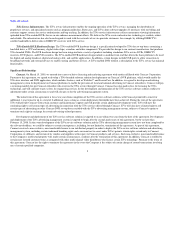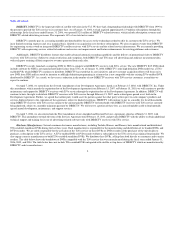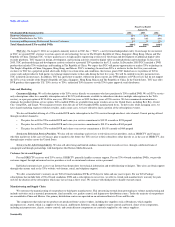TiVo 2005 Annual Report Download - page 17
Download and view the complete annual report
Please find page 17 of the 2005 TiVo annual report below. You can navigate through the pages in the report by either clicking on the pages listed below, or by using the keyword search tool below to find specific information within the annual report.
Table of Contents
We have incurred significant net losses and have had substantial negative cash flows. During the fiscal years ended January 31, 2006, 2005 and 2004,
our net loss were $(34.4) million, $(79.8) million, and $(32.0) million, respectively. As of January 31, 2006, we had an accumulated deficit of $(691.5)
million. The size of future net losses will depend in part on our subscription revenues and on our expenses. We will need to generate significant additional
revenues to achieve profitability. Although we did reach profitability for the three months ended July 31, 2005, we may not reach profitability again or be able
to sustain or increase profitability on a quarterly or annual basis in the future.
We face intense competition from a number of sources, which may impair our revenues, increase our subscription acquisition cost, and hinder
our ability to generate new subscriptions.
The DVR market is rapidly evolving, and we face significant competition. Moreover, the market for in-home entertainment is intensely competitive and
subject to rapid technological change. As a result of this intense competition, we could incur increased subscription acquisition costs that could adversely
affect our ability to reach or sustain profitability in the future. If new technologies render the DVR market obsolete, we may be unable to generate sufficient
revenue to cover our expenses and obligations.
We believe that the principal competitive factors in the DVR market are brand recognition and awareness, functionality, ease of use, availability, and
pricing. We currently see two primary categories of DVR competitors: DVRs offered by cable and satellite operators and DVRs offered by consumer
electronics companies.
Within each of these two categories, the competition can be further segmented into those offering what we define as basic DVR functionality and those
offering enhanced DVR functionality. Basic DVR functionality includes no or limited program guide data and "VCR-like" controls with manual timeslot-
based recordings, usually with no DVR service fee after the consumer purchases the enabling hardware. The TiVo Basic service offered on select TiVo-
enabled DVD recorders made by Toshiba and Pioneer is an example of basic DVR functionality. Enhanced DVR functionality includes rich program guide
data and enhanced scheduling and personalization features, and may or may not require a DVR service fee. The TiVo service, required for most TiVo-enabled
DVRs, and offered as an upgrade for select TiVo-enabled DVD recorders made by Toshiba and Pioneer, is an example of enhanced DVR functionality.
Satellite and Cable DVR Competitors. We compete against cable and satellite set-top boxes that integrate DVR functionality.
• Satellite: EchoStar offers a range of DVR models, including standard definition and high definition models, most of which offer dual tuner
capabilities. Certain models can output signals to multiple TVs within the household. Certain models now offer name-based recordings instead of
timeslot-base recordings. DIRECTV has introduced a competing DVR service from NDS. The current DIRECTV DVR from NDS does not
support recording of high-definition broadcasts.
• Cable: Cable operators have made DVR technology available on set-top boxes from Scientific-Atlanta and Motorola. These products combine
digital and analog cable reception with DVR functionality; some versions offer dual tuner and/or high definition capabilities Other competition in
the cable DVR market comes from other software providers including TV Guide, Microsoft, Aptiv Digital and Digeo.
U.S. cable operators are currently deploying server-based Video on Demand (VOD) technology from SeaChange, Concurrent, and others, which could
potentially evolve into competition. Additionally, we are aware of at least one U.S. cable operator, Cablevision, Inc., which has announced plans to test
server-based DVR technology. Server-based VOD and DVR technology rely on content servers located within the cable operator's central head-end that
stream video across the network to a digital cable set-top box within the consumer's home. Cable operators can use server-based VOD and DVR technology to
deliver movies, television shows, and other content to consumers. Consumers can watch this programming on demand, with VCR-like pausing and rewinding
capabilities. Operators can charge consumers for access to VOD content on a per-transaction or monthly subscription basis, or can offer content without
charge. To the extent that cable operators offer regular television programming as part of their server-based VOD and offerings DVR technology, consumers
have an alternate means of watching time-shifted shows besides DVRs.
13
























